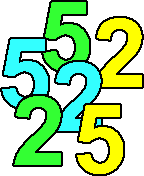Fac-finding
Problem

Getting Started
How many numbers between one and one hundred have a factor of five and how many have more than one factor that is five?
Student Solutions
Another well attempted problem with solutions from Mary of Birchwood High School, Sana, Jenny, Chris and Rosion of Madras College, St. Andrews, as well as Andrei of School 205 Bucharest and Chen of the Chinese High School, Singapore.
$$100! = 100 \times99 \times98 \times97 \times97 \times \ldots \times4 \times3 \times2 \times1$$
To write this as the product of its prime factors:
Considering some examples:
$100 = 2^2 \times5^2$
$80 = 2^4 \times5$
So to find all the $2$'s that appear as prime factors it is
necessary to consider all the numbers divisible by powers of $2$
between $1$ and $100$
Number of numbers divisible by $2 = 2^1$ is $50$ (the even numbers
- with at least one $2$ as a factor)
Number of numbers divisible by $4 = 2^2$ is $25$ (with at least two
$2$'s as factors)
Number of numbers divisible by $8 = 2^3$ is $12$ (with at least
three $2$'s as factors)
Number of numbers divisible by $16 = 2^4$ is $6$ (with at least
four $2$'s as factors)
Number of numbers divisible by $32 = 2^5$ is $3$ (with at least
five $2$'s as factors)
Number of numbers divisible by $64 = 2^6$ is $1$(with six $2$'s as
factors).
Therefore number of $2$'s is $50 + 25 + 12 + 6 + 3 + 1 = 97$
Similarly:
Number of numbers divisible by $5 = 5^1$ is $20$ (the even numbers
- with at least one $2$ as a factor)
Number of numbers divisible by $25 = 5^2$ is $4$ (with at least two
$2$'s as factors)
Therefore number of $5$'s is $20 + 4= 24$
Andrei from "Tudor Vianu" National College, Bucharest, confirmed that $100!$ Has $24$ zeros are at the end of this large number. He then provided an excellent table which he could then use to see that the first digit to precede them was $4$
Here's how this table works. There are a lot of prime factors in $100!$ but Andrei has organised the data so that counting them isn't too hard.
We already know there are $97$ prime factors that are $2$ ($24$ of which are used with the available fives to create those $24$ trailing zeros)
$100!$ means one multiplied with two multiplied with three . . . . multiplied with $100$.
Which of all those factors will contain a prime factor of three?
$3, 6, 9,\ldots 99$ all will (that's $33$ so far)
Which will contain a second prime factor of three?
$9, 18, 27 \ldots99$ (that's $11$ more, so now $44$ so far)
which will contain a third prime factor of three?
$27, 54, 8$1 (that's $3$ extra) and $81$ has four prime factors of $3$ (so one more, making $48$ in all)
Find that "$48$", showing the frequency of the prime factor of three, in Andrei's table.
The fives have all been used up getting the zeros.
There's less work involved in doing the sevens:
$7, 14, 21,$ to $98$ ( $14$ so far )
$49$ and $98$ have a second factor of $7$ (total $16$, find it in the table)
There are only $25$ prime numbers smaller than one hundred so checking isn't too big a job, and the bigger numbers involve almost no work so don't be discouraged.
Now the smart thing about Andrei's table is the way the numbers are arranged.
It's the final (units) digit that we are interested in so it's only the last digit we need to consider. For example the prime factors of $11, 31, 41, 61,$ and $71$ will all have the same effect on that last digit. Look down the other columns in the table to see similar groupings and the frequency total at the bottom.
Now all the ones will create a final one.
Numbers ending in $3$ will form a product whose final digit will depend on how many numbers were multiplied but will follow a cycle of $3, 9, 7, 1$ then $3$ again. So with $64$ numbers multiplied the final digit is a one.
Reasoning likewise the numbers ending in $7$ have a product ending in $3$, and the $11$ prime factors ending in $9$ will produce a final digit of $9$
The twos follow a cycle and the last digit of their product is $2$.
Finally the product of all those last digits has a last digit of $4$, so $4$ is the digit that immediately precedes the zeros.
Many thanks Andrei.
Teachers' Resources
I like the twist that means you need to take a little care - you need to worry about detail.
Although it uses factorial notation, this is only a very minor part of the problem- basically it means you can make your point succinctly - that is what mathematical notation is all about.
Possible extension.
My additional question of how many zeros also points out that an apparently closed problem can be easily opened up, with further questions to be asked.
This problem is a special case of Factorial Fun.
Possible support
See also Powerful Factorial and Factoring Factorials which are also special cases.
